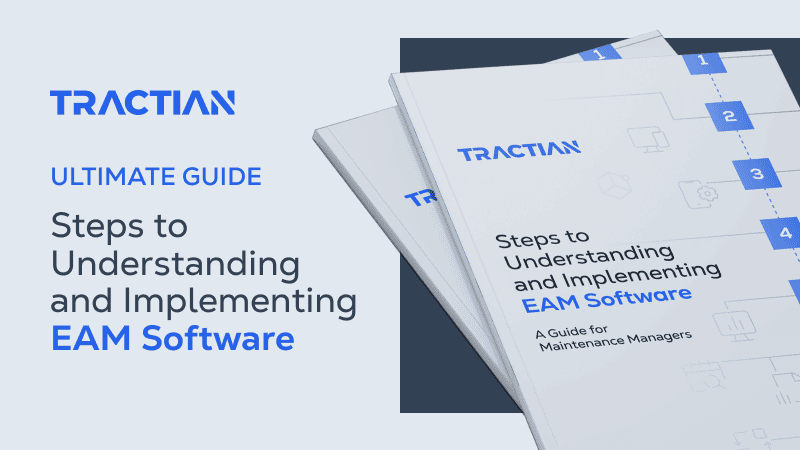Your assets work harder when they're properly maintained. Yet most companies don't realize how their lack of proper maintenance is leaving on the table. Every piece of equipment sitting idle, every unplanned breakdown, and every inefficient process directly impacts your bottom line.
Fortunately, there’s a metric that reveals the connection between asset investment and the revenue it generates. The industry refers to this operational truth as asset turnover.
Asset turnover shows exactly how many dollars of revenue you generate for every dollar invested in equipment, inventory, and facilities. It's the clearest window into whether your operation is squeezing maximum value from its resources or letting expensive assets underperform.
This article will walk you through the complete asset turnover calculation, show you what good performance looks like across different industries, and reveal proven strategies for improving your ratio through smarter maintenance and operational decisions.
What Is Asset Turnover
Asset turnover measures how efficiently a company uses its assets to generate revenue. It’s calculated by dividing net sales by average total assets. This financial ratio tells you whether a business is squeezing maximum value from every dollar invested in equipment, inventory, and other resources.
Think of it like this: if you own a food truck, your assets include the truck itself, cooking equipment, and inventory. Asset turnover reveals the number of dollars of sales you generate for every dollar tied up in the same assets. A higher ratio means you're working your assets more effectively and generating more revenue per dollar invested.
Purpose: Asset turnover serves as an efficiency thermometer for resource utilization. It reveals whether management is deploying assets effectively or letting valuable resources sit idle.
Importance: Investors and managers rely on this metric because it cuts through the noise of complex financial statements. A company might show strong sales growth, but if it's accumulating assets faster than revenue, efficiency is actually declining.
Context: Asset turnover complements other financial ratios to paint a complete picture. While profit margins show how much you keep from each sale, asset turnover reveals how hard your assets work to generate those sales in the first place.
Here's what the ratio signals about business performance:
- High ratio indicates efficient use of assets, lean operations, and strong management execution
- Low ratio indicates potential inefficiencies, an asset-heavy business model, or underutilized resources
So what’s the key insight? Don’t think of asset turnover as just an exercise to run through. Asset turnover is a critical indicator of operational discipline and the strategic use of assets.
3 Steps to Calculate Asset Turnover
Calculating asset turnover requires two pieces of financial data that every business tracks: revenue and total assets. The process breaks down into three straightforward steps that anyone can follow with basic financial statements.

1. Gather Revenue and Assets Data
Revenue is reported on the income statement, typically listed as "net sales" or "total revenue." This figure includes all money earned from core business operations but excludes one-time gains, interest income, or other non-operating revenue sources.
Total assets are listed on the balance sheet and represent everything the company owns, including cash, inventory, equipment, buildings, and investments. You'll need asset values from both the beginning and end of the period you're analyzing.
2. Find Average Total Assets
Since asset levels fluctuate throughout the year, you need the average rather than a single point-in-time figure. The formula for calculating the average total assets is simple: add the beginning total assets to the ending total assets, then divide by two.
For example, to calculate average total assets, you add the amount of assets at the beginning and end of the year, then divide by two.
Example: ($1 M + $1.2 M) ÷ 2 = $1.1 M average assets.
3. Apply the Asset Turnover Formula
Once you have both numbers, divide revenue by average total assets. For example, if a company's revenue is twice as large as its average total assets, its asset turnover ratio would be 2.0.
Example: $4 M revenue ÷ $2 M average assets = 2.0.
This shows they were able to generate revenue efficiently relative to the assets they owned during the period. The higher this number, the more efficiently they're using their asset base to drive sales.
Asset Turnover Equation and Formula
The core asset turnover formula is straightforward. But several variations help analyze different aspects of asset efficiency. Let's look at how each version targets specific types of assets or operational areas.
The total asset turnover formula yields a ratio expressed as a numerical value, not a percentage. A higher asset turnover ratio indicates that a company is generating more sales for every dollar invested in its assets, while a lower ratio suggests less efficient use of those assets.
Understanding these variations helps you drill down into specific areas of asset management. Fixed asset turnover measures how effectively a company utilizes its long-term investments, such as machinery and buildings. In contrast, working capital turnover focuses on short-term operational assets, including inventory and receivables.
The asset turnover ratio formula remains consistent across industries. However, the interpretation varies dramatically based on business models and capital requirements.
Examples of Asset Turnover in Action
Real-world examples illustrate how asset turnover calculations work and why the same ratio can have different meanings across industries. These scenarios show the complete calculation process and interpretation.
Retail Scenario
Consider a clothing retailer generating annual revenue from sales. Their balance sheet reflects a change in total assets from the start to the end of the year.
First, calculate asset turnover using the average total assets formula: ($800,000 + $1,000,000) ÷ 2 = $900,000
Next, apply the formula: $2,400,000 ÷ $900,000 = 2.67
This retailer generates $2.67 in sales for every dollar of assets. For retail businesses, this represents solid efficiency because they typically maintain lean asset bases with fast inventory turnover and minimal fixed assets.
Manufacturing Scenario
A manufacturing company generates annual revenue and holds significant assets at both the beginning and end of the reporting period.
Average total assets: ($4,000,000 + $6,000,000) ÷ 2 = $5,000,000
Asset turnover is calculated by dividing a company's revenue by its average total assets.
This manufacturer generates $1 in sales per dollar of assets. While lower than the retailer, this reflects the capital-intensive nature of manufacturing, where expensive equipment and facilities are necessary to produce goods.
What’s the key insight? Context matters more than the absolute number when you compute asset turnover across different business models.
Interpreting the Asset Turnover Ratio
Understanding what the asset turnover ratio means requires looking beyond the numbers to industry context and business model characteristics. A ratio of 2.0 might signal excellent efficiency in one sector while indicating potential problems in another.
Industry context: Comparing asset turnover across industries is akin to comparing the fuel efficiency of a sports car to that of a freight truck. Retail companies typically achieve higher ratios because they operate with minimal fixed assets and fast inventory cycles. Utilities show lower ratios due to massive infrastructure investments that generate steady but proportionally smaller revenue streams.
Trend analysis: Changes in a company's ratio over time reveal more than absolute values. A declining trend might indicate growing inefficiency, overinvestment in assets, or market challenges. An improving trend suggests better asset utilization or successful operational improvements.
Limitations: Asset turnover doesn't measure profitability or asset quality. A company might achieve high turnover by selling products at break-even prices, or by using aging equipment that will soon require replacement.
Here's a look at how this plays out in different industries:
- Retail businesses often have higher asset turnover ratios because their models are inventory-focused and involve relatively few fixed assets.
- Manufacturing businesses tend to have moderate asset turnover ratios due to the equipment-intensive nature of their operations.
- Utilities companies typically have lower asset turnover ratios due to their substantial infrastructure requirements.
Understanding these patterns helps you evaluate whether a company's asset turnover aligns with industry norms or signals operational strengths and weaknesses.
What Is a Good Asset Turnover Ratio
Determining what is a good asset turnover ratio depends entirely on industry benchmarks and business model requirements, with no universal standard applying across all sectors. What matters most is how a company's ratio compares to that of its direct competitors and whether it's improving over time.
High-turnover industries: Grocery stores, restaurants, and discount retailers typically achieve ratios above 2.0 because they move inventory quickly and operate with minimal fixed assets. These businesses succeed by maximizing sales volume per dollar invested.
Low-turnover industries: Telecommunications, utilities, and heavy manufacturing often exhibit ratios below 1.0 due to massive capital requirements. These companies invest heavily in infrastructure that generates revenue over the course of many years.
Warning signs: Regardless of industry, certain patterns indicate potential problems. A rapidly declining ratio might signal overinvestment, market share loss, or operational inefficiencies. Conversely, an extremely high ratio could indicate underinvestment in necessary assets or unsustainable cost-cutting.
Asset efficiency extends beyond the ratio itself to encompass how well management balances growth investments with current performance. The best companies in any industry typically show stable or gradually improving ratios while maintaining competitive positioning.
The goal isn't to achieve the highest possible ratio, but to optimize the balance between asset investment and revenue generation for long-term success.
3 Ways to Improve Asset Turnover
Companies can boost their asset turnover through strategic approaches that either increase revenue without adding assets or reduce asset levels while maintaining or improving sales performance. The most effective improvements target operational efficiency and strategic asset management.
1. Streamline Inventory Management
Excess inventory ties up capital without generating additional revenue, directly hurting asset turnover. Just-in-time inventory systems, demand forecasting improvements, and supplier relationship optimization can reduce inventory levels while maintaining service levels.
Smart inventory management also involves identifying slow-moving or obsolete stock and liquidating it before it becomes a permanent drag on efficiency. Companies that master this balance free up cash while improving their turnover metrics.
2. Optimize Maintenance and Scheduling
Proper maintenance prevents downtime and extends asset life, improving overall efficiency by maximizing productive output from existing investments. When equipment runs reliably, companies generate more revenue per dollar invested in assets without incurring additional capital expenditures.
CP Kelco saved $483K last year through improved reliability strategies. "I'm really impressed by the reliability metrics that TRACTIAN is able to calculate in real time, and the level of detail when it comes to the failure modes and the insight generation. TRACTIAN has really improved our asset availability," said Gautam Sane, CP Kelco Senior Reliability Engineer.
Higher uptime lets the same asset base generate more revenue, lifting the ratio. Automated scheduling and real-time tracking help eliminate unplanned downtime. Streamline asset data with Tractian CMMS so maintenance tasks never slip through the cracks.
3. Strengthen Sales and Pricing Tactics
Increasing revenue through better sales strategies affects the ratio without changing asset levels. This may involve improving pricing strategies, expanding into new markets, or refining the product mix to focus on higher-margin offerings.
Sales improvements offer the fastest path to better asset turnover because they directly impact the numerator in the calculation while leaving the denominator unchanged.
Asset Turnover vs. Fixed Asset Turnover
While both ratios measure asset efficiency, they focus on different components of a company's asset base and serve distinct analytical purposes. Understanding when to use each ratio helps you get clearer insights into operational performance.
The fixed asset turnover ratio measures how effectively a company utilizes its property, plant, and equipment to generate sales. This metric proves especially valuable for capital-intensive industries where fixed assets represent the majority of total assets.
Formula: Fixed Asset Turnover = Revenue ÷ Average Net PP&E
For example, a manufacturing company might exhibit mediocre total asset turnover due to high inventory levels, but an excellent fixed asset turnover ratio, indicating efficient use of production equipment. This distinction helps identify whether efficiency problems stem from operational issues or capital allocation decisions.
Asset turnover in the fixed asset calculation often runs higher than total asset turnover because the denominator excludes current assets, such as cash and inventory, that don't directly generate revenue.
Asset Turnover in DuPont Analysis
Asset turnover serves as a critical component in DuPont analysis, a framework that breaks down return on assets into its underlying drivers. This analysis reveals how asset turnover, combined with profit margins, determines overall financial performance.
The DuPont formula shows: ROA = Profit Margin × Asset Turnover
This relationship demonstrates that companies can achieve strong returns through either high profit margins or efficient asset utilization. Some businesses excel at premium pricing (high margins), while others succeed through volume and efficiency (high asset turns).
For instance, luxury retailers often focus on higher profit margins with lower asset turnover, while discount retailers typically operate with lower margins but achieve higher asset turnover. Both can deliver similar returns on assets through different strategic approaches.
Understanding this relationship helps managers identify which lever to pull for improvement. Companies with low margins might focus on cost reduction or premium positioning, while those with low asset turnover should emphasize operational efficiency and asset optimization.
Key Takeaways for Driving Operational Efficiency
Asset turnover ratio means more than just a financial metric. It's a lens for viewing operational discipline and strategic focus. The asset turnover equation divides revenue by average total assets. However, asset turnover interpretation requires industry context and trend analysis to generate meaningful insights.
The calculation method remains consistent: gather revenue from the income statement, calculate total asset turnover using balance sheet data, then divide revenue by average assets. However, what constitutes good performance varies dramatically across industries and business models.
Companies improve their ratios through inventory optimization, maintenance excellence, and revenue enhancement strategies. The goal isn't to maximize the ratio at all costs, but to find the optimal balance between asset investment and revenue generation for sustainable growth.
Common pitfalls include comparing ratios across unrelated industries, focusing solely on absolute values rather than trends, and ignoring the relationship between asset turnover and profitability. The most valuable insights come from understanding how asset efficiency contributes to overall business performance.
Better visibility over maintenance can lift the ratio. Boost operational control with Tractian CMMS to make informed, proactive decisions that keep your asset turnover high.
How Tractian's CMMS Can Elevate Your Operation
Asset turnover improvement, in essence, is about pursuing operational excellence to maximize revenue from every dollar invested in assets. The right maintenance management system transforms how efficiently your assets generate value and directly impacts your turnover ratio through reduced downtime and extended asset life.
Most companies struggle with asset efficiency because they lack real-time visibility into equipment performance and maintenance needs. When assets fail unexpectedly or operate below capacity, revenue suffers. Asset values remain unchanged, which in turn drag down turnover ratios.
Tractian's CMMS addresses this challenge by providing complete asset visibility and proactive maintenance scheduling. Work orders, asset histories, and preventive maintenance schedules integrate seamlessly, ensuring your equipment operates at peak efficiency. Real-time monitoring and automated alerts prevent small issues from becoming major failures that hurt both revenue and asset utilization.
Our CMMS goes beyond basic scheduling to deliver AI-powered insights that optimize maintenance timing and resource allocation. Mobile-first design enables technicians to update asset status instantly, maintaining accurate records that support better decision-making. The result? Higher asset availability, improved operational efficiency, and stronger asset turnover performance.
Implementation happens fast with zero-cost onboarding and intuitive interfaces that require minimal training. Your team starts seeing results immediately, not after months of complex setup and configuration.



